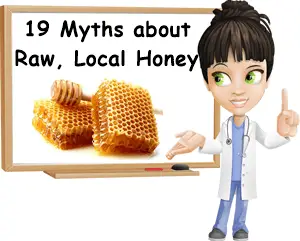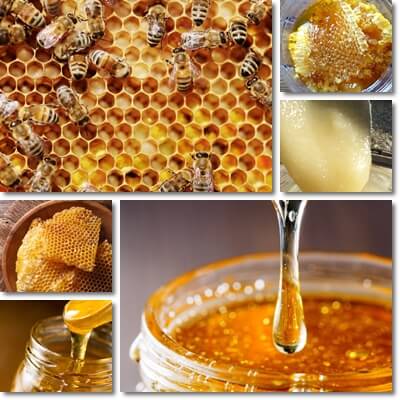Honey is indeed a source of good health and energy and truly one of the best natural foods to eat. However, there are a lot of myths about honey and what it looks and tastes like and just as many myths about what you can and cannot do with it. From baking with honey as a healthier alternative to table sugar, to raw, local honey treating pollen allergies and crystallized honey being spoilt or real honey not crystallizing, here are the top 19 myths and facts about honey:
Honey is exclusively made by honey bees (myth)
Although they are called honey bees and they do produce most of the honey humans and other animals eat, they aren’t the only insects to make honey. Other bee species, such as some stingless bees and even some wasps make honey. Honeydew honeys, also called forest honeys, such as pine honey, silver fir, oak, beechwood and spruce honey are special varieties made from honeydew secreted by aphids which feed on the sap of these tree species.
See the benefits of pine honey.

All bees make honey (myth)
It’s incorrect to say all bees make honey. Actually, only a few species of bee make honey, in amounts high enough to have commercial value and of a high enough quality to be suitable for human consumption. This honey myth is perpetuated by the longstanding belief and gross generalization that honey comes from honey bees alone (hence their extremely telling name).
Honey bees don’t eat honey (myth)
Nature is filled with intent and the real reason why honey bees and other honey-producing insects make honey is to feed themselves and their offspring. So, yes, it’s true that honey bees eat honey too.
Honey is not considered sugar (myth)
There isn’t a bigger myth out there! Honey may be natural, healthy and a better alternative to regular table sugar, but it’s still sugar. The average sugar content in honey is 80-82% and it’s mainly fructose and glucose (two simple forms of sugar that naturally exist in fruits, fruit juices, vegetables, maple syrup and other natural syrups and, of course, honey). Table sugar is essentially sucrose, a slightly more complex sugar made up of fructose and glucose as well.
When digested, sucrose is broken down into fructose and glucose, the same sugars in honey. The only reason why raw honey is better than table sugar is because table sugar is 99.7% to 99.9% sugar, vs honey which is only 80-82%.

Real honey is liquid (myth)
Real honey is actually naturally viscous, with a thicker consistency compared to water and other fluids. While it is liquid, in the sense that it takes the shape of the container it is put in like other fluids, it has a slower flow. But it does drip from a spoon. The flow is slower, given its thicker consistency, and once down, it should settle in a thick droplet. Real honey doesn’t spill and doesn’t spread. Its consistency is owed to its natural composition: 80-82% sugar and about 17% water.
Honey is made from pollen (myth)
Honey is actually made from flower nectar and, to a lesser extent, water. It does contain pollen particles, because, well, cross-contamination mostly, but it’s mostly flower nectar fermented by honey bees (digested and regurgitated, that is). Pollen does exist though. Other elements present in honey include yeasts, beeswax particles, micronutrients (vitamins, minerals), proteins, antioxidants, aromatic compounds (volatile organic compounds), even dust particles.
Real honey doesn’t crystallize (myth)
Actually, a great way to tell if your honey is real and unprocessed is to see if it crystallizes. Most honeys will crystallize within a few months to a year following collection from the beehive. Crystallization is a normal, natural process that occurs with raw honey. Crystallization does not take away from the properties or benefits of the honey. Aside from the perfectly reversible change in texture, the honey will also retain its original flavor and is perfectly safe to eat. A lot of commercial honey is pasteurized and adulterated (corn syrup, table sugar, whether cane or beet, and other sugars and even water are added to it), with the sole purpose of keeping it liquid longer.
Crystallized honey is spoilt (myth)
Crystallized honey is merely honey that has solidified. It’s still perfectly safe to eat and retains the same taste and flavor compounds as it did in the beginning. The only downside is that its crystallized state renders some of its uses more difficult. Honey that doesn’t crystallize is often a sign of adulteration and pasteurization.
You shouldn’t use a metal spoon for honey (myth)
If you leave a metal spoon in the sink for several months, or outside, the humidity will eventually cause the metal to corrode. Honey too has about 17% water content, but since you don’t leave your metal spoon in the honey jar for months or years in a row, it’s perfectly safe and okay to eat honey with a metal spoon.
Honey is better for baking than sugar (myth)
It’s a myth that honey is better for baking than regular table sugar. Yes, it’s healthier than regular white table sugar, but it’s still mostly sugar itself. And sugar still causes reactions that could result in the production of potentially carcinogenic compounds when heated for longer periods of time, especially above a certain heating point. Heating honey above a certain point also causes destruction of beneficial antimicrobial compounds, antioxidants and even essential nutrients, alters aromatic profile and simply does not provide any additional benefit compared to regular table sugar (in cooking). Baking with honey instead of sugar is a myth originating in two gross generalizations: one, that sugar is inherently bad for you, in all forms and amounts (although you need it to live), and two, that honey is universally healthy, in all forms and preparations (it’s not).
Honey is good for babies (false)
It’s true that you mustn’t give raw honey to babies under 1 year of age. The raw honey can carry Clostridium botulinum spores (spores produced by the Clostridium botulinum bacterium). The bacterium releases a neurotoxin that causes the disease known as botulism. Children under 1 have not yet developed the intestinal flora to resist colonization with this bacterium and can suffer severe side effects, including paralysis, as well as respiratory failure which can be fatal if not addressed in time. Giving them raw honey is bad.
All honey is yellow (myth)
Yellow is the most common color for honey, but not the only one. Normal honey color ranges from a clear, very light yellow (such as in black locust or false acacia honey and alfalfa honey) to amber (such as in lime, basswood or linden honey) to a medium dark amber color with a deep, saturated orange-brown or reddish pigment (such as in eucalyptus honey) to a dark amber with reddish hues (such as in buckwheat honey). Forest honeys can have green reflections, while honey blends (a mix of more monofloral honeys) tend to be darker-colored.
Local honey is the healthiest (myth)
While its more eco-friendly to get local honey because of the reduced costs of transportation (getting from producer to end consumer is cost-effective), it’s more important how the honey is made. Ideally, bee colonies should have access to flowers from uncontaminated areas of land, where there is no use of pesticides on crops and no pollution from factories or industrial waste, car exhaust fumes etc. Also, if a person if allergic to plant species native to where they live, eating a local honey would put them in contact with native plant pollen and increase risks of allergic reactions.
Honey doesn’t spoil (half a myth)
It’s actually true that, in the right conditions, real honey doesn’t spoil. It has to be kept sealed so that it doesn’t absorb moisture from its surroundings, but can be kept for years and still be safe and good to eat. If unsealed, it eventually spoils. It all depends on how it is stored.
Some honeys don’t have pollen (myth)
Honey is made from nectar, not pollen, but it will contain pollen too. Pollen count ranges greatly from variety to variety, season to season, batch to batch, but it exists. Modern filtration methods can reduce pollen count considerably, but do not and cannot guarantee a pollen-free honey.
Honey is naturally without impurities (myth)
We are sold the myth that real, raw, healthy honey is a brilliant golden-yellow color, more liquid than viscous and clear, without any visible impurities. This is false. The truth is that honey is sealed in honeycombs by honey bees. Removing it often leads to various particles such as beeswax and pollen grains and even air bubbles being left in the honey. Honey that is ultra-clear, uniform in texture, a seamlessly flowing liquid has been filtered, but filtration usually also includes pasteurization which denatures the natural properties of the honey and reduces its nutritional value, however insignificant, for the sake of appearance and a more familiar texture.
Eating local honey is good for allergies (myth)
This is a myth originating in a medical approach to allergies known as desensitization, or allergen immuno-therapy. Basically, gradual exposure to increasing amounts of an allergen is believed to increase tolerance to said allergen by modulating a favorable immune system response. However successful in a medical setting, the procedure itself has been know to cause severe allergic reactions (anaphylactic shock) and is not something to try at home. If you are allergic to honey, honey bees or one or multiple pollen sources, avoid honey in all forms and preparations.
Creamed honey is raw (myth)
Creamed honey that you buy at the supermarket or online is commonly processed honey. Creaming honey is meant to prevent natural crystallization (which yields coarser sugar crystals) and give the honey a more desirable and familiar texture, a texture that simply sells better, and lasts longer. To cream honey, raw honey is usually pasteurized, then stirred to obtain finer sugar crystals that result in a creamier texture.
All honey is natural (myth)
Honey has been adulterated since the beginning of time. In the past, people would mix it with various sweet, sugary plant syrups. Now, it’s readily mixed with cheap sugar syrups such as corn syrup to make it stay liquid longer, be more fluid than it naturally is (because apparently that appeals to the majority of consumers), and to reduce production costs while maintaining maximum profits. Read the label to see what exactly your honey contains, beware of suspiciously low prices and discounts, be suspicious of honey that flows too easily, buy local and be happy when your honey crystallizes.
